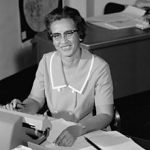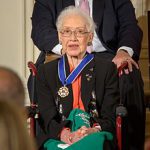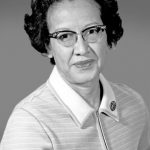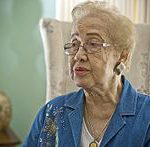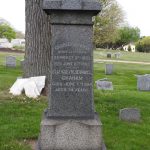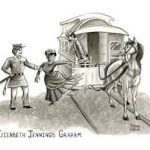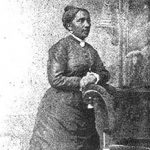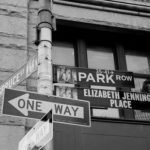I am so sorry for the delay in this. It has been a tough week for the two of us here and we hope you can forgive us! It just means you get two blogs closer together. 🙂
- Katherine at NASA in 1966
- Being awarded the Presidential Medal of Freedom in 2015
- Portrait of Katherine Johnson Credits: NASA
- Katherine Johnson in 2008
Name: Katherine Johnson
Born: August 26, 1918 Died: Not Dead Yet!
What they did: Badass mathematician that helped us go to space and to the moon!
Facts:
- Born Katherine Coleman in 1918 in White Sulphur Springs, West Virginia.
- Katherine showed strong mathematical abilities from an early age. Because Greenbrier County did not offer public schooling for African-American students past the eighth grade, the Colemans arranged for their children to attend high school in Institute, West Virginia.
- Katherine was enrolled when she was only 10 years old.
- Katherine graduated from high school at 14 and entered West Virginia State, a historically black college. As a student, she took every math course offered by the college.
- She had many mentors here including:
- Chemist and mathematician Angie Turner King
- W. W. Schieffelin Claytor, the third African-American to receive a PhD in math
- She had many mentors here including:
- She graduated summa cum laude in 1937, with degrees in mathematics and French, at age 18.
- She took on a teaching job at a black public school in Marion, Virginia.
- When West Virginia decided to quietly integrate its graduate schools in 1939, West Virginia State’s president Dr. John W. Davis selected Katherine and two male students as the first black students to be offered spots at the state’s flagship school, West Virginia University.
- Katherine left her teaching job, and enrolled in the graduate math program. At the end of the first session, however, she decided to leave school to after becoming pregnant and choosing to focus on her family.
- 1952 that a relative told her about open positions at the all-black West Area Computing section at the National Advisory Committee for Aeronautics’ (NACA’s) Langley laboratory
- Katherine began work at Langley in the summer of 1953.
- Katherine has referred to the women in the pool as virtual “computers who wore skirts”.
- From 1953 to 1958, Katherine worked as a “computer”, analyzing topics such as gust alleviation for aircraft.
- Katherine was reassigned to the Guidance and Control Division of Langley’s Flight Research Division. It was staffed by white male engineers.
- Katherine and the other African-American women in the computing pool were required to work, eat, and use restrooms that were separate from those of their white peers. Their office was labeled as “Colored Computers”.
- NACA disbanded the colored computing pool in 1958 when it was superseded by NASA, which adopted digital computers.
- In 1956, James Goble died due to an inoperable brain tumor.
- In 1957, Katherine provided some of the math for the 1958 document Notes on Space Technology, a compendium of a series of 1958 lectures given by engineers in the Flight Research Division and the Pilotless Aircraft Research Division (PARD).
- She did trajectory analysis for Alan Shepard’s May 1961 mission Freedom 7, America’s first human spaceflight.
- In 1960, she and engineer Ted Skopinski coauthored Determination of Azimuth Angle at Burnout for Placing a Satellite Over a Selected Earth Position, a report laying out the equations describing an orbital spaceflight in which the landing position of the spacecraft is specified. It was the first time a woman in the Flight Research Division had received credit as an author of a research report.
- In 1962, as NASA prepared for the orbital mission of John Glenn, Katherine was called upon to do the work that she would become most known for.
- The computers had been programmed with the orbital equations that would control the trajectory of the capsule in Glenn’s Friendship 7 mission, from blast off to splashdown, but the astronauts were wary of putting their lives in the care of the electronic calculating machines, which were prone to hiccups and blackouts.
- As a part of the preflight checklist, Glenn asked engineers to “get the girl”—Katherine Johnson—to run the same numbers through the same equations that had been programmed into the computer, but by hand, on her desktop mechanical calculating machine. “If she says they’re good,’” Katherine Johnson remembers the astronaut saying, “then I’m ready to go.”
- When asked to name her greatest contribution to space exploration, Katherine Johnson talks about the calculations that helped synch Project Apollo’s Lunar Lander with the moon-orbiting Command and Service Module.
- On May 5, 2016, a new 40,000-square-foot (3,700 m2) building was named “Katherine G. Johnson Computational Research Facility” and formally dedicated at the agency’s Langley Research Center in Hampton, Virginia.
- West Virginia State University announced plans for an endowed STEM scholarship in honor of Katherine and a life-size statue of her on campus.
- On May 12, 2018 she was awarded an honorary doctorate by the College of William and Mary. This was one day before here 100th birthday.
- She is still alive and kicking at 100 years old!
- Grave Site
- Illustration of Elizabeth Jennings Graham being removed from the Third Ave. Streetcar…Pinterest
- Elizabeth Jennings Graham
- Her street
Name: Elizabeth Jennings Graham
Born: March, 1827 Died: June, 1901
What she did: African American Teacher and Civil Rights Figure
Facts:
- Elizabeth was born in March of 1827(ish. Dates differ according to her death certificate and census records) as a free African American.
- She was one of 5 children. Her father, Thomas L. Jennings was a free man when Elizabeth was born and became a successful tailor and influential member of New York’s black community.
- Her mother, also named Elizabeth, was born into slavery but later categorized as an indentured servant until 1827.
- Thomas used the money he earned from his patented dry-cleaning process to buy his wife’s freedom.
- By 1854, Elizabeth Jennings Graham became a schoolteacher and church organist, teaching at the African Free School, an institution founded in 1787 to provide education to children of slaves and free people of color.
- In the 1850’s, horse-drawn street cars on rails were a common mode of transportation.
- These street car lines were privately owned which allowed owners and drivers to refuse service to passengers and enforce segregated seating.
- On July 16 , 1854, Elizabeth was running late to play the organ at the First Colored Congregational Church. She boarded a streetcar owned by the Third Avenue Railroad Company, which only catered to white passengers, at the corner of Pearl Street and Chatham Street.
- Elizabeth was initially given permission to ride as long as none of the white passengers complained. Then, the conductor ordered her to get off. When Elizabeth politely told him no the conductor tried to remove her by force.
- Only with the aid of a police officer was Elizabeth removed from the streetcar.
- Elizabeth later wrote of the incident, “I was a respectable person, born and raised in New York, did not know where he was born and that he was a good for nothing impudent fellow for insulting decent persons while on their way to church.”
- This didn’t set well with the black community organized movement to end racial
discrimination on streetcars was formed led by Elizabeth’s father, Reverend James W.C Pennington, and Reverend Henry Highland Garnet. - Elizabeth wrote a letter that detailed the incident and read it in church the next day.
- The letter was eventually published by famed abolitionist and escaped slave Frederick Douglass in his newspaper.
- The story gained national attention and Thomas filed a lawsuit on Elizabeth’s behalf against the driver, conductor, and the Third Avenue Railroad Company.
- Elizabeth was represented by 24-year-old lawyer Chester A. Arthur.
- In 1855, the court ruled in Elizabeth’s favor.
- Brooklyn Circuit Court Judge William Rockwell said, “Colored persons, if sober, well behaved, and free from disease, had the same rights as others and could neither be excluded by any rules of the company, nor by force or violence.”
- Elizabeth was awarded damages in the amount of $250, which is just over $7,000 in today’s money, along with $22.50 in costs, or $653.73 today.
- Elizabeth’s case set the precedent for future cases.
- African American activists formed the Legal Rights Association to continue fighting for equality.
- It would be another decade in 1865, until New York’s public transit services were completely desegregated.
- After the trial, Elizabeth continued working as an organist and teacher. She married Charles Graham the two had a son named Thomas in 1862.
- Unfortunately, Thomas died of convulsions at 1 year old. He died during the New York Draft Riots and Elizabeth and her husband had to seek the help of a white undertaker and sneak through the streets to bury their son.
- Her husband died in 1867.
- In 1895, Elizabeth operated a kindergarten for African American children out of her home. The school was in operation until her death on June 5, 1901.
- The first biography on her wasn’t published until 2018.
- In 2019, Chirlane McCray, First Lady of New York City, announced there would be a statue honoring Elizabeth erected near Grand Central Terminal.
- In 2007, New York City co-named a block of Park Row “Elizabeth Jennings Place”.
